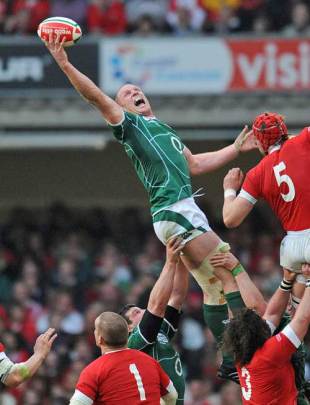|
Rugby Primer
Lineouts
Scrum.com

© Getty Images
Enlarge
A scrum is called a set piece. The other common set piece in rugby is the lineout. After a ball has been kicked or run into touch (out of bounds), the forwards of each team will line up at the spot indicated by the touch judge as the touch mark. Normally, the hooker of the team being awarded the ball will be the person to throw the ball back into the lineout. The other forwards will lineup at least 5 metres away from him but no further than 15 metres. The opposing team will lineup to match their counterparts. Someone on the team with the throw-in will call a coded signal indicating who the ball will be thrown to and any subsequent move. At the same time the flyhalf should also be calling a move. The hooker will then throw the ball to the intended receiver who has jumped into the air. Most often the throw is to the locks who are jumping in the second and fourth positions in the lineout supported by the players on either side of them. Once a jumper does jump, these supporting players are allowed to lift him higher into the air and hold him there. Once the ball is secured, most often many of the forwards on both sides of the ball bind together and a maul will ensue until the ball is produced for another phase. © Scrum.com
|
Live Sports
Communication error please reload the page.
-
Football
-
Cricket
-
Rugby
-
- Days
- Hrs
- Mins
- Secs
F1 - Abu Dhabi GP
Abu Dhabi Grand Prix December 11-131. Max Verstappen ()
2. Valtteri Bottas (Mercedes)
3. Lewis Hamilton (Mercedes)
4. Alexander Albon ()
5. Lando Norris ()
6. Carlos Sainz Jr ()
-
ESPNOtherLive >>
Darts - Premier League
Golf - Houston Open
Snooker - China Open
Tennis - Miami Open

